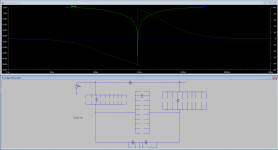Thank you!
As PCBs are being shipped, Samuel Groner posted the schematic and construction and application notes for the notch filter on his web site - see under the "Passive Notch Filter". I updated the first post in this thread with this link as well.
As PCBs are being shipped, Samuel Groner posted the schematic and construction and application notes for the notch filter on his web site - see under the "Passive Notch Filter". I updated the first post in this thread with this link as well.
Last edited:
I built a stupid little spreadsheet based on Ken Kuhn's article on Hall Networks
http://www.kennethkuhn.com/electronics/design_and_applications_of_the_hall_network.pdf
interesting to play with before building
Index of /ProAudio/Hall Network
Cheers
Alan
http://www.kennethkuhn.com/electronics/design_and_applications_of_the_hall_network.pdf
interesting to play with before building
Index of /ProAudio/Hall Network
Cheers
Alan
I'm afraid the Excel formula in the cell G6 is not quite correct - if you use =1/(2*PI()*D5*(C5*0.000001)*SQRT((3))) instead, it will give you the correct notch frequency of 918.88Hz for the untuned filter.I built a stupid little spreadsheet based on Ken Kuhn's article on Hall Networks
http://www.kennethkuhn.com/electronics/design_and_applications_of_the_hall_network.pdf
interesting to play with before building
Index of /ProAudio/Hall Network
Cheers
Alan
Regards,
Braca
??
I don't follow the assumptions you have used
are you referencing the Kuhn article and equations?
( with the scaling you use you should use C6 not C5 )
FYI I am using open office calc to write this, not supposed to make any difference on simple spreadsheets, but....
I don't follow the assumptions you have used
are you referencing the Kuhn article and equations?
( with the scaling you use you should use C6 not C5 )
FYI I am using open office calc to write this, not supposed to make any difference on simple spreadsheets, but....
Last edited:
OK, still not sure of your assumptions, probably you're better at math than me and reducing equations (not surprising). But I did find two stupid mistakes in my original file (since corrected)
one was notational about PI and the other was me being stupid. No, R*R is not 2R, oops.
Hey, if you want better coding have my sister write it, she writes code for Fermi Lab.
Anyway, I fixed my errors and the formula now gives the same results as DNI's while maintaining the original form of the equation.
Cheers and enjoy
Alan
one was notational about PI and the other was me being stupid. No, R*R is not 2R, oops.
Hey, if you want better coding have my sister write it, she writes code for Fermi Lab.
Anyway, I fixed my errors and the formula now gives the same results as DNI's while maintaining the original form of the equation.
Cheers and enjoy
Alan
Last edited:
I apologize for not having explained the expression I posted. It is a mathematical equivalent to Kuhn's Eq. (3) for the case C1=C2=C3 and R1=R2.OK, still not sure of your assumptions, probably you're better at math than me and reducing equations (not surprising). But I did find two stupid mistakes in my original file (since corrected)
one was notational about PI and the other was me being stupid. No, R*R is not 2R, oops.
Hey, if you want better coding have my sister write it, she writes code for Fermi Lab.
Anyway, I fixed my errors and the formula now gives the same results as DNI's while maintaining the original form of the equation.
Cheers and enjoy
Alan
I've been programming all my life and when I see a mathematical formula to be programmed I instinctively simplify it for faster execution and a shorter statement.
The full formula will be needed if the effects of components' tolerances upon the filter performance are to be studied.
Incidentally, there is a neat tool for calculating resistor combinations that will be needed for tuning this filter. It certainly saved me quite a lot of time:
Excel spreadsheet finds ALL possible series and parallel resistor solutions
Regards,
Braca
Last edited:
- Home
- Group Buys
- PCB for Samuel Groner's low distortion passive notch filter

